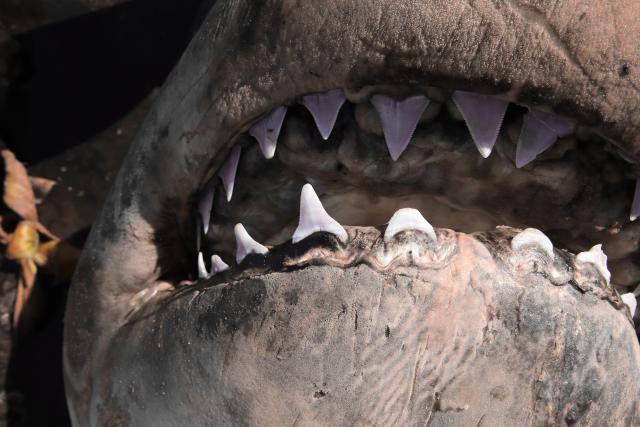
15-foot dead shark washes up on beach, leads to ‘treasure trove’ of info for Northeast researchers
A 15-foot great white shark recently washing up on a beach has led to a “treasure trove” of information for Northeast apex predator researchers.
NOAA Fisheries researchers during the last week of February responded to a report of a dead 15-foot female white shark that washed up on the shores of Navarre Beach, Florida, in the Gulf of Mexico. A circle hook was in the corner of the shark’s jaw, a sign that the great white was recently caught and released.
The shark — which researchers believe was close to 30 years old — was then transported to the NOAA Southeast Fisheries Science Center facility in Panama City, where scientists conducted a necropsy, or animal autopsy.
While the team was not immediately able to determine the cause of death, they collected extremely rare samples from the large apex predator.
“Any opportunity to collect biological samples and data from a white shark is incredibly important for understanding their life history,” said Michelle Passerotti, fish biologist in the Northeast Fisheries Science Center Apex Predators Program.
“While strandings like this one are fairly rare even in the northern Atlantic where they have more resident populations, this event is extremely rare in the Gulf of Mexico and provides a treasure trove of information for this species,” Passerotti added.
One of the most fascinating discoveries from this dissection was the fact that the 15-foot female, though estimated to be close to 30 years old, was not reproductively mature.
Initial speculations that the shark was pregnant were not accurate. This particular species can live to be near 80 years old, and females are thought to mature between 30 and 35 years of age. This finding was quite a surprise for the biologists.
Related Articles
Massive shark tagged by Cape Cod researcher makes shark science history: ‘A dream come true’
Off Massachusetts coast, dozens of North Atlantic right whales unexpectedly spotted in shipping lanes
Cape Cod shark researchers share ‘incredible’ video footage from the view of a 3,000-pound great white
Sharks scavenge carcass of North Atlantic right whale with ties to Cape Cod
Shark sightings across New England: Where were the great white shark hotspots last year?
“I was amazed that she was still immature,” said John Carlson, a NOAA Fisheries research biologist who helped with the necropsy. “Previously, we thought most females could reproduce at this size. This shows just how little we know about these animals.”
A team of eight biologists conducted the necropsy, spending several hours collecting precise measurements, recording detailed notes, and dissecting the animal to gain valuable samples and information about the shark.
“While white sharks are more common in the Gulf of Mexico than most people realize, they are rarely encountered by our survey programs,” said Heather Moncrief-Cox, a NOAA Fisheries affiliate with the Cooperative Institute for Marine and Atmospheric Science.
“In fact, this is only the fourth white shark that the Southeast Fisheries Science Center Shark Population Assessment Group has been able to collect biological samples from, and the first that we’ve had the opportunity to perform such an extensive necropsy on,” Moncrief-Cox added.
The shark’s body condition was considered normal and healthy; there were no indications of starvation, disease, or trauma. The shark’s liver was considered to be healthy. Additional tissues from all major organs were sent for pathology to further screen for potential causes of mortality.
Researchers examine the body of the dead great white shark. (NOAA Fisheries/Meaghan Emory)


